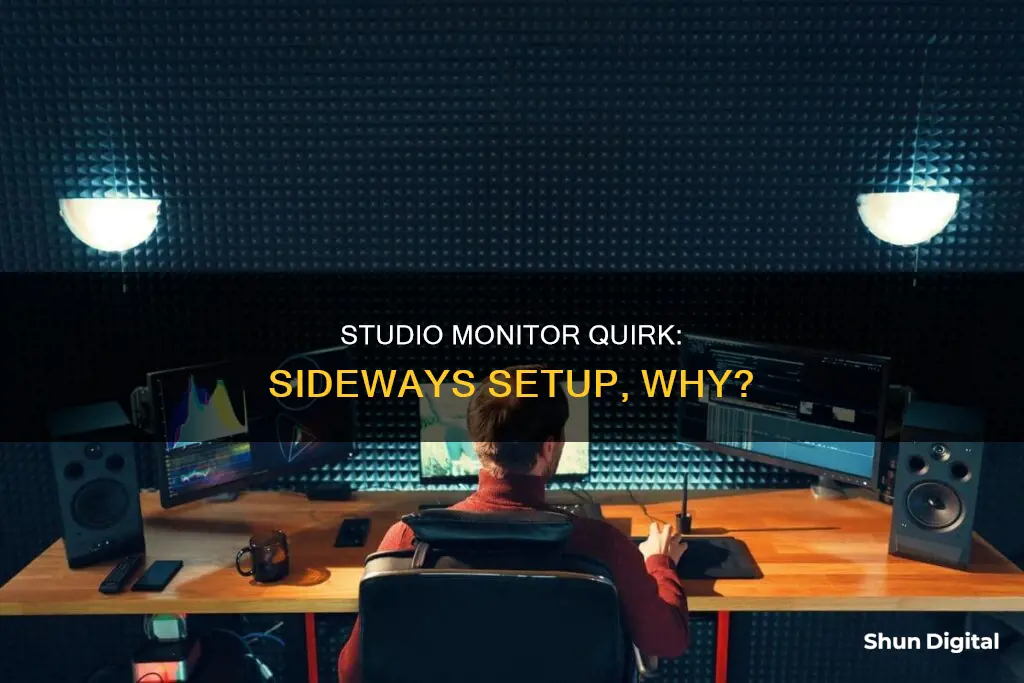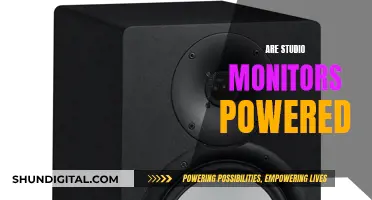
Studio monitors are usually placed upright and vertically. However, some people prefer to place them sideways or horizontally. There are various reasons for this, including space limitations, aesthetic preferences, and the belief that it improves sound quality. While some monitors are designed to be placed horizontally, doing so with monitors designed for vertical placement can negatively impact sound quality, stereo imaging, and frequency response.
| Characteristics | Values |
|---|---|
| Reasoning | To see through into the live room, to save space, to look cool, to have the tweeter at ear level, to avoid having to turn the head, for stability, for aesthetics, to avoid blocking the view of bigger mains behind |
| Impact on sound | Affects time alignment, introduces time differences between tweeter and woofer, results in strange, unstable and disconnected stereo image, changes to the frequency response, bass response and stereo image |
| Speakers designed for sideways placement | NS-10s, Neumann KH310, Dynaudio LYD48 |
What You'll Learn

Some studio monitors are designed to be placed sideways
However, it is important to note that placing monitors sideways can also have negative effects on the sound quality. When monitors are designed, the positioning of the tweeter and bass driver is carefully considered to ensure the sounds from each arrive at the listener's ears at the same time. When monitors are placed sideways, this alignment is disrupted, causing the different frequency components of a specific sound source to appear to come from different places, resulting in a strange and unstable stereo image. This effect is known as "comb filtering" and can lead to phase cancellation, causing the sound to become coloured and less accurate. Additionally, the wide horizontal dispersion angle that is intended to maximise the stereo image width and 'sweet spot' listening area is reduced when monitors are placed sideways, resulting in a narrower 'sweet spot' and more colouration.
St Jude Hospital: Performance Monitoring Strategies and Secrets
You may want to see also

Sideways monitors can affect the stereo image and sound colouration
Studio monitors are designed to be placed in a specific orientation. When placed sideways, the horizontal and vertical dispersion patterns are affected, resulting in a narrower "sweet spot" and a change in the way many instruments sound.
The "sweet spot" is the middle position between the two sides of a stereo system, where the speakers overlap, and it is where the stereo image is at its best. When monitors are placed sideways, the "sweet spot" becomes narrower, meaning that the optimal listening position is more restricted.
Additionally, the mid-frequency "pinch" becomes audible when monitors are placed sideways, which changes the way many instruments sound. This "pinch" occurs around the crossover frequency, where the tweeter and woofer are trying to reproduce the same signals. As a result, the sound becomes more coloured and less accurate, with different frequency components of a specific sound source appearing to come from different places.
The bass response can also be affected when monitors are placed sideways. The bass driver may end up closer to the mounting surface than intended, resulting in changes to the frequency response in the bass region.
Furthermore, placing monitors sideways can disrupt the cooling mechanism of powered monitors, leading to potential overheating issues.
In summary, placing studio monitors sideways can affect the stereo image and sound colouration by altering the dispersion patterns, introducing a mid-frequency "pinch", affecting the bass response, and potentially causing overheating issues.
Surviving the Dating Game with an Ankle Monitor
You may want to see also

Sideways monitors can cause issues with mixes
Studio monitors are designed to be placed in a specific orientation, and altering their position can affect the sound quality and accuracy. While some monitors are designed to be placed horizontally, most are intended for vertical placement.
Placing studio monitors sideways can cause issues with mixes, and here are some reasons why:
Stereo Imaging and Sound Accuracy
The tweeter and bass driver in conventional studio monitors are vertically aligned so that the sounds from each driver reach the listener simultaneously. When monitors are placed sideways, the sounds from the tweeter and woofer arrive at the listener's ears at different times, resulting in a strange and unstable stereo image. This timing difference can cause a comb-filtering effect due to phase cancellation, leading to sound colouration and inaccuracies. The colouration becomes more pronounced as the listener moves left or right from the central listening position.
Sweet Spot and Reflections
Most studio monitors are designed with a wide horizontal dispersion angle to maximise the stereo image width and the "sweet spot" listening area. By placing the monitors sideways, the dispersion characteristics are altered, resulting in a narrower sweet spot and increased surface reflections. This, in turn, leads to more colouration, comb filtering, and other unwanted effects.
Bass Response
The bass driver in studio monitors is typically mounted a certain distance from the bottom of the cabinet. When the monitors are placed sideways, the bass driver may be closer to the mounting surface than intended, affecting the frequency response in the bass region. This can deviate from the designer's intentions and impact the accuracy of the monitors.
Cooling and Stability
Some powered studio monitors have finned cooling heatsinks on the rear panel that function vertically. Placing the monitors sideways disrupts the airflow, reducing cooling efficiency and potentially leading to overheating and component failure. Additionally, some monitor designs may become unstable when placed on their sides without proper support or a cradle.
While there may be valid reasons for placing studio monitors sideways, such as sightline considerations or space limitations, it is essential to be aware of the potential issues it can cause with mixes. It is recommended to refer to the manufacturer's documentation and follow their placement guidelines whenever possible.
The Perfect Viewing Angle: ASUS Monitor Stand Secrets
You may want to see also

Sideways monitors can be placed like this for stability or aesthetics
Studio monitors are usually placed upright and vertically, but some people prefer to place them sideways, or horizontally. There are several reasons why someone might choose to place their studio monitors sideways, including for stability or aesthetics.
Studio monitors can be large and bulky, and placing them sideways can help to save space, especially if the monitors are placed on a desk or console. This can also help to improve line-of-sight, allowing producers to see through into a live room.
Placing studio monitors sideways can also be done for aesthetic reasons, as it gives the studio a unique look. Some people may prefer the way it looks, especially if they have seen it in magazines or studios of famous producers.
It is important to note that placing studio monitors sideways can affect the sound quality and stereo image. Unless the monitors are designed to be placed sideways, it can disrupt the directivity characteristics, causing a shift in the tonal response and a narrower "sweet spot". It can also cause issues with cooling, as the airflow becomes disrupted and less efficient.
Overall, while placing studio monitors sideways can be done for stability or aesthetics, it is important to consider the potential impact on sound quality and make adjustments as needed.
Enabling Multi-Monitor Setup via BIOS on ASUS Devices
You may want to see also

Sideways monitors can be used to improve line of sight
Studio monitors are usually placed upright and vertically. However, some people prefer to place them sideways, or horizontally. While this can be done for aesthetic reasons or to save space, it can also improve the line of sight.
Placing studio monitors sideways can improve the line of sight by preventing the monitors from blocking the view of the live room. This is especially relevant in recording studios, where producers and engineers need a clear view of the performers. By placing the monitors sideways, they can be positioned above the producer's head, either on the desk or on a rack/mount, without obstructing the line of sight.
Additionally, placing studio monitors sideways can also improve the line of sight by reducing their physical separation. When placed upright, the tweeter and woofer are vertically aligned, resulting in a larger physical separation. By turning the monitors sideways, the tweeter and woofer are brought closer together, reducing the overall width of the setup. This can be advantageous in smaller studios or when desk space is limited.
It is worth noting that placing studio monitors sideways can have an impact on sound quality and stereo imaging. The horizontal placement can degrade the stereo image and affect the frequency response, resulting in a narrower "sweet spot". Therefore, it is recommended to refer to the manufacturer's instructions and experiment with different orientations to find the best setup for the specific studio environment.
Overall, placing studio monitors sideways can be a viable option to improve the line of sight, especially in studios where clear visibility of the live room is important. However, it is important to consider the potential impact on sound quality and make adjustments accordingly.
Cleaning LCD Screens and Monitors: Safe Solutions and Techniques
You may want to see also
Frequently asked questions
Some people place studio monitors sideways because they feel the tweeter and driver should be level. Others do it because they feel the speaker is too high and this solves the issue. Some studio monitors are designed to be placed sideways, like the NS-10 line.
Placing studio monitors sideways can save space and allow for better placement. It can also make it easier to see into the live room from the control room.
Placing studio monitors sideways can affect the time alignment and lead to issues with mixes. It can also disrupt the cooling mechanism of powered monitors, causing them to overheat.
Optimal sound can be achieved by placing studio monitors away from walls and corners, forming an equilateral triangle with your listening position, and situating your mix position symmetrically in the room.







